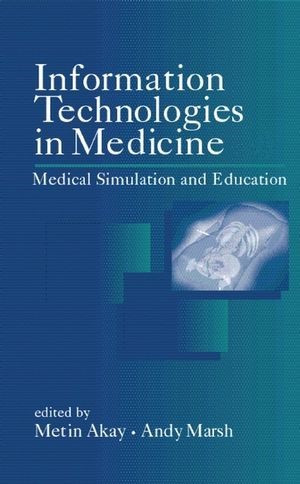Read more
The two volumes of Information Technologies in Medicine thoroughly explore the use of VR technology in three-dimensional visualization techniques, realistic surgical training prior to patient contact, and actual procedures in rehabilitation and treatment, including telemedicine and telesurgery. Editors Akay and Marsh have brought together all the available information on the subject of VR technologies in medicine and medical training to create the first comprehensive guide to the state of the art in medicine for use by students, doctors, and researchers.
List of contents
VOLUME 1: MEDICAL SIMULATION AND EDUCATION.
PREFACE.
PART I: ARTIFICAL ENVIRONMENT AND MEDICAL STIMULATOR/EDUCATION.
1. Virtual Reality in Medicine and Biology (Richard A. Robb).
2. VEs in Medicine; Medicine in Ves (Adrie C. M. Dumay).
3. Virtual Reality and Its Integration into a Twenty-First Century Telemedical Information Society (Andy Marsh).
4. Virtual Reality and Medicine?Challenges for the Twenty-First Century (Joseph M. Rosen).
5. Virtual Reality Laboratory for Medical Applications (Gabriele Faulkner).
6. Medical Applications of Virtual Reality in Japan (Makoto Yoshizawa, Ken-ichi Abe, Tomoyuki Yambe, and Shin-ichi Nitta).
7. Perceptualization of Biomedical Data (Emil Jovanov, Dusan Starcevic, and Vlada Radivojevic).
8. Anatomic VisualizeR: Teaching and Learning Anatomy with Virtual Reality (Helene Hoffman, Margaret Murray, Robert Curlee, and Alicia Fritchle).
9. Future Technologies for Medical Applications (Richard M. Satava).
INDEX.
VOLUME 2: REHABILITATION AND TREATMENT.
PREFACE.
PART I: TREATMENT.
1. Neuro/Orthopedic Rehabilitation and Disability Solutions Using Virtual Reality Technology (Walter J. Greenleaf).
2. The Use of Virtual Reality Technology in the Treatment of Anxiety Disorders (Brenda K. Wiederhold and Mark D. Wiederhold).
3. Virtual Reality for Health Care (L. Beolchi and G. Riva).
4. Robot-Assisted Microsurgery Development at JPL (Hari Das, Tim Ohm, Curtis Boswell, Rob Steele, and Guillermo Rodriguez).
5. Virtual Reality and the Vestibular System: A Brief Review (Erik Viirre, Zsolt Lorant, Mark Draper, and Thomas A. Furness, III).
PART II: TELEMEDICINE AND TELESURGERY.
6. Computer Imagery and Multimedia Techniques for Supporting Telemedicine Diagnoses (Qinglian Guo, Katsunobu Muroi, and Mieko Ohsuga).
7. Implementing a Picture-Achieving and Communication System (PACS) and Teleradiology System: Practical Issues and Considerations (Jihong Wang).
8. From Engineering to Surgery: The Harsh Realities of Virtual Reality (Robert John Stone).
9. Maxillofacial Virtual Surgery from 3-D CT Images (Alessandro Sarti, Roberto Gori, Alberto Bianchi, Claudio Marchetti, and Claudio Lamberti).
INDEX.
About the author
Metin Akay, PhD, is an interim chair and Professor of Bioengineering in the Harrington Department of Bioengineering at Arizona State University (ASU). He is Editor of the IEEE Press Series on Biomedical Engineering and the author, coauthor, or editor of fourteen books. His current research interests at the ASU Neural Engineering and Informatics, Wearable Technology, and Sensors Labs include the dynamics of motor function in Parkinson and post-stroke disease subjects, and the effect of developmental abnormalities and maturation on the dynamics of respiration.
ANDY MARSH is a researcher at the National Technical University of Athens in Athens, Greece.
Summary
Dieses zweibändige Werk beschäftigt sich mit Virtual-Reality-Anwendungen in der Medizin. Behandelt werden neueste Entwicklungen verschiedener VR-gestützter Behandlungsmethoden wie Telemedizin und Telechirurgie. Im Mittelpunkt dieses 2. Bandes "Information Technologies in Medicine" stehen Technologien für Rehabilitation und Behandlungsmaßnahmen.

